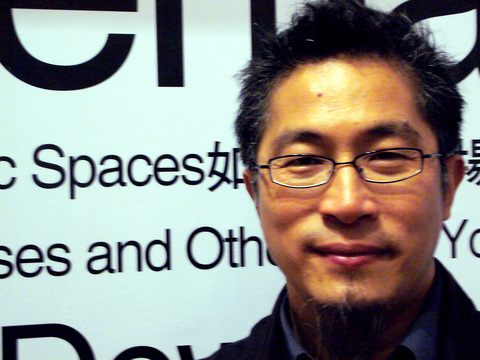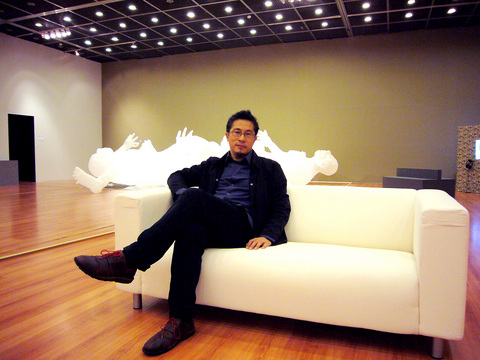The common perception of a curator is a highly educated, distinguished man in a three-piece suit, smoking a pipe and leafing through old archive photos of ancient masters. Though Manray Hsu (徐文瑞) has a PhD in philosophy from Columbia University and wears a button down shirt, the independent curator who is based in Taipei and Berlin rarely spends time looking through boxes in the archives of old museums.
Like many contemporary artists, Hsu is concerned with how art affects our daily lives and creates a dialogue within the global and local contexts. This notion shapes his entire outlook on the art he chooses for exhibits, such as Naked Life, currently running at the Museum of Contemporary Art, Taipei (MOCA).
Hsu differentiates between independent curators from institutional curators in two ways. First, he points out that independent curators don't work in or have an ongoing collaboration with any particular museum. Instead, they spend time moving from one museum or biennial to another picking and choosing projects that are most suited to their aesthetic vision. The corollary to this is that independent curators are also intellectually independent.

PHOTOS: NOAH BUCHAN, TAIPEI TIMES
"Freelance curators have [the] freedom … to develop ideas and projects in [their] own way. If you work in an institution you are more limited as to what you can do and what you can not do," he said.
Hsu also says that working independently enables the curator to collaborate closely with artists, which normally wouldn't be the case working inside an institution. "For me, independent means that I'm also more in contact with artists and those people in the field."
Collaborating with artists and working in the "field" has only become common in the past few decades. Until the 1970s, curators were predominately trained in art history, which had a tremendous influence on what hung on the walls of museums. "You still have an exhibition, but you don't rely on art history anymore. You can still do it, but art history is not the only framework. So you need to have people who can provide a smaller framework but still much bigger than the individual artwork. That's the curator's job. Framework providers," he said.

For Hsu, creating the proper framework for an exhibit necessarily involves a lot of travel because he seeks input from international artists.
"My job relies on my traveling. But an important part of this issue is contemporary culture, [which is] a global culture. There is no simple big narrative that can allow you to say, okay, I know the whole art world. So you need to have people from different parts of the world who can bring their perspective and their experience into the field. And normally these people are curators and theorists," he said.
Hsu's global perspective is readily apparent with the current lineup of artists exhibiting at MOCA who hail from as far a field as Iraq and as close to home as Japan. "[By] traveling, I've built my own conceptual network and this is another thing I bring into the art world," Hsu said.
According to Hsu, his extensive travels combined with a global outlook and a desire to directly cultivate talent fosters greater trust between the curator and artists because the latter are working directly with an individual, rather than an institution. The curator can then have a clearer picture of what the artist is trying to achieve because both sides are working together.
How art is classified according to culture is an important issue to Hsu who believes stereotypes of what a particular culture will produce need to be broken down.
One common notion that Hsu wants to rid the art world of is the idea that an artist's work is inseparable from their nationality.
"Just because this artist is from Iraq, then everything he does has to do with Iraq — this, for me, doesn't really make sense," he said. "When a Western artist exhibits in a professional exhibition, normally the exhibition will not mention the locality [where the ideas are formed] and I feel this is more questionable."
"Some artists are really conscious of their local history and some artists work on more formalistic issues inside art history so the idea of locality [is] relevant to artists in different ways, no matter if it is Western [or] Eastern."
The relevance of national history, borders and educational background is, Hsu believes, becoming less important. The question facing institutions is: can they react quickly enough?
Part of reacting to and participating in the social environment — whether global or local — involves formulating theories that help people understand the processes of change. For the biennial held earlier this year in Liverpool, Hsu developed an idea that shows how art can rejuvenate public spaces. Known as "archipuncture" it reveals how artwork in the public realm is connected to the energy flow of the city through its placement at particular points.
"Archipuncture for me ... provide[s] a perspective of how art can be related to the urban condition. Instead of just something that you look at … art also brings new energy flows to the place where it is exhibited. And this kind of new energy can be related to the health of the city," he said. Hsu makes it clear that this idea can be applied to any city throughout the world.
The exhibit at MOCA, in a similar manner to the 2006 Liverpool Biennial, involves both a global and local perspective. The title of the exhibit is meant to explore the contemporary mode of existence where anti-terrorism, border control and the gradual erosion of due process has stripped many citizens of their political rights and legal protections. The concepts embodied in Naked Life should have particular resonance for Taiwanese because of the country's forty-year history of martial law.
Naked Life is an attempt to raise awareness of global issues in a local context that moves beyond the cynicism of the polarizing politics that Hsu claims pervades Taiwan .

On April 26, The Lancet published a letter from two doctors at Taichung-based China Medical University Hospital (CMUH) warning that “Taiwan’s Health Care System is on the Brink of Collapse.” The authors said that “Years of policy inaction and mismanagement of resources have led to the National Health Insurance system operating under unsustainable conditions.” The pushback was immediate. Errors in the paper were quickly identified and publicized, to discredit the authors (the hospital apologized). CNA reported that CMUH said the letter described Taiwan in 2021 as having 62 nurses per 10,000 people, when the correct number was 78 nurses per 10,000

As we live longer, our risk of cognitive impairment is increasing. How can we delay the onset of symptoms? Do we have to give up every indulgence or can small changes make a difference? We asked neurologists for tips on how to keep our brains healthy for life. TAKE CARE OF YOUR HEALTH “All of the sensible things that apply to bodily health apply to brain health,” says Suzanne O’Sullivan, a consultant in neurology at the National Hospital for Neurology and Neurosurgery in London, and the author of The Age of Diagnosis. “When you’re 20, you can get away with absolute

May 5 to May 11 What started out as friction between Taiwanese students at Taichung First High School and a Japanese head cook escalated dramatically over the first two weeks of May 1927. It began on April 30 when the cook’s wife knew that lotus starch used in that night’s dinner had rat feces in it, but failed to inform staff until the meal was already prepared. The students believed that her silence was intentional, and filed a complaint. The school’s Japanese administrators sided with the cook’s family, dismissing the students as troublemakers and clamping down on their freedoms — with

As Donald Trump’s executive order in March led to the shuttering of Voice of America (VOA) — the global broadcaster whose roots date back to the fight against Nazi propaganda — he quickly attracted support from figures not used to aligning themselves with any US administration. Trump had ordered the US Agency for Global Media, the federal agency that funds VOA and other groups promoting independent journalism overseas, to be “eliminated to the maximum extent consistent with applicable law.” The decision suddenly halted programming in 49 languages to more than 425 million people. In Moscow, Margarita Simonyan, the hardline editor-in-chief of the